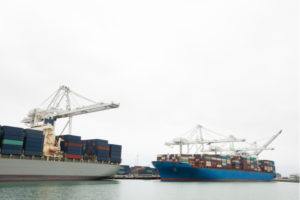
Port cranes offload cargo containers from sea vessels. Port of Los Angeles, Los Angeles, CA, USA. By Matt Gush @ Shutterstock.com
In the Financial Times, David Bowers analyzes the long-term effects that may be presented by today’s supply chain breakdown. He writes:
Most policymakers have only known a world where demand has been limited and supply has been elastic. Whatever the demand, China has been ready and willing to meet it as the world’s supplier of last resort.
The policy response to the pandemic has upset that balance. High levels of saving and government transfers during lockdowns have underwritten a dramatic rebound in global demand but failed to prepare supply, creating a bullwhip effect. Now it is supply that appears to be constrained and “inelastic”.
That is a very different policy environment — one where restoring global equilibrium in the goods market becomes more difficult; where national output gaps take on more significance; and where ensuring sufficient local inventories of goods takes on greater importance for both countries and corporates.
The longer the supply-chain crisis continues, the more inclined companies will be to rethink their business models. They may decide to invest more to reshore production; they may vertically integrate to take back control of their supply chains; they may start to over-order and carry higher inventory as they shift from a just-in-time to a just-in-case model.
Adapting to these challenges will place additional demands on corporates’ free cash flow and balance sheets. And they could have macroeconomic consequences. Inventory build-up and depletion is a key driver of the economic cycle. The longer inventory levels stay elevated, the more volatile they could become — as could the business cycle.
Read more here.
